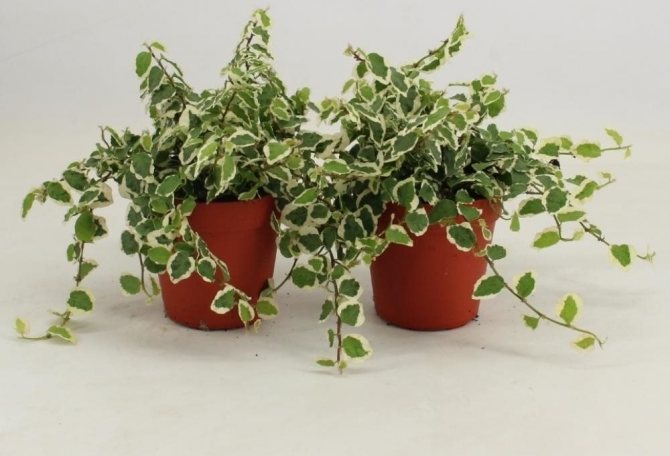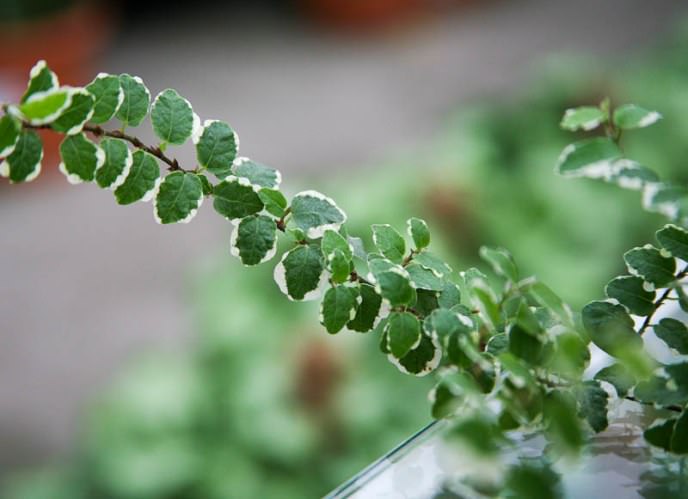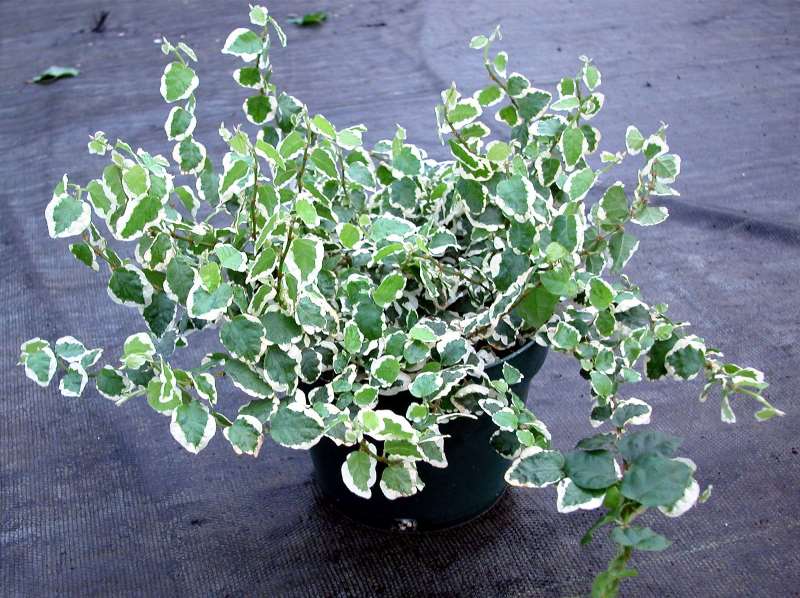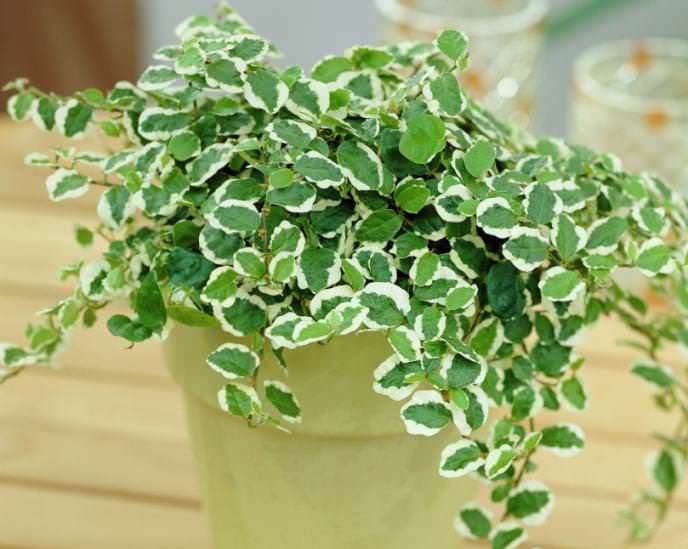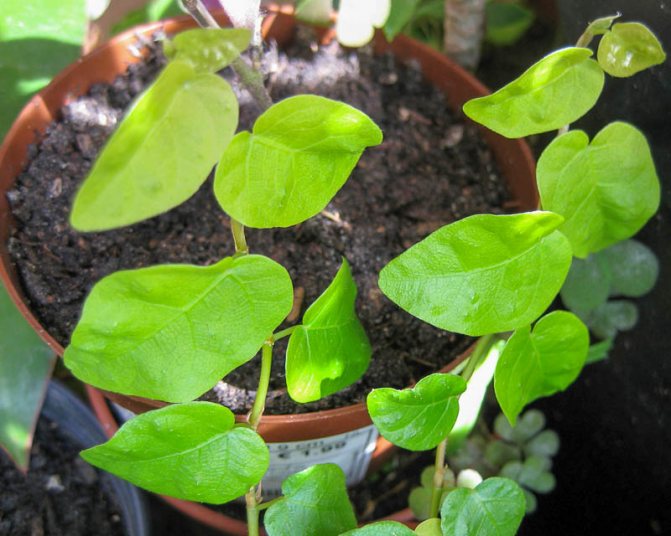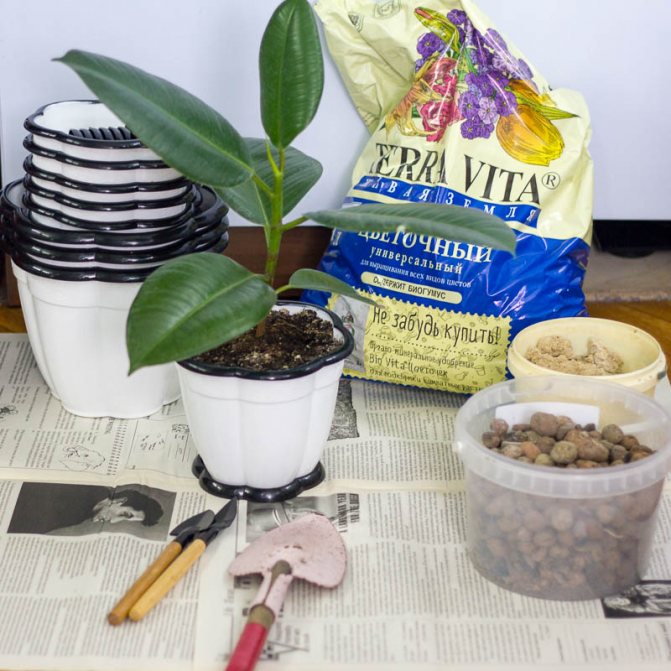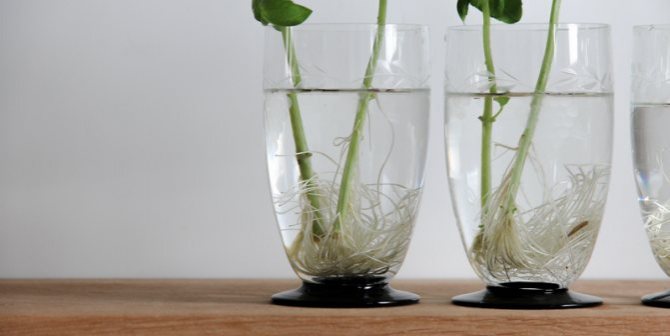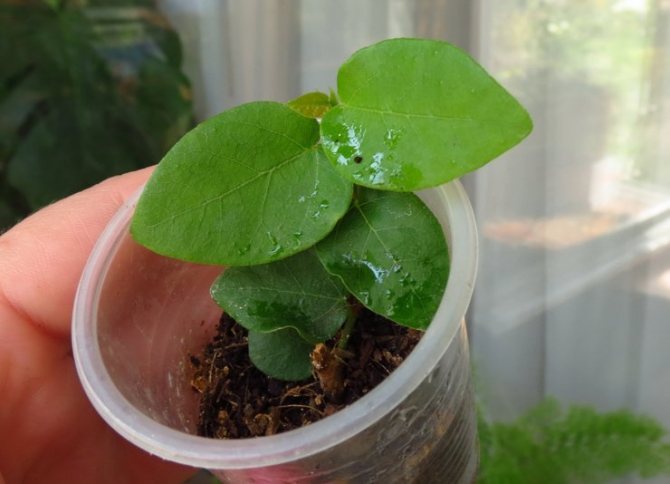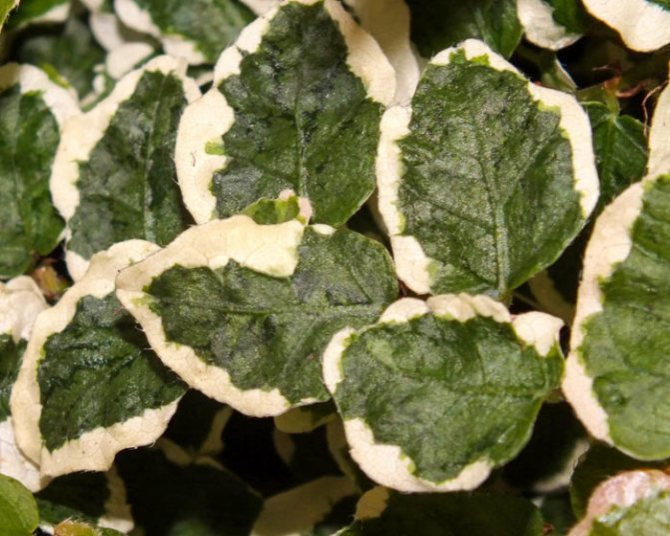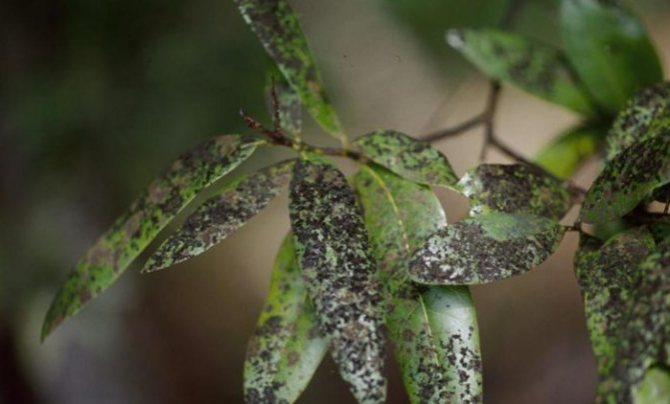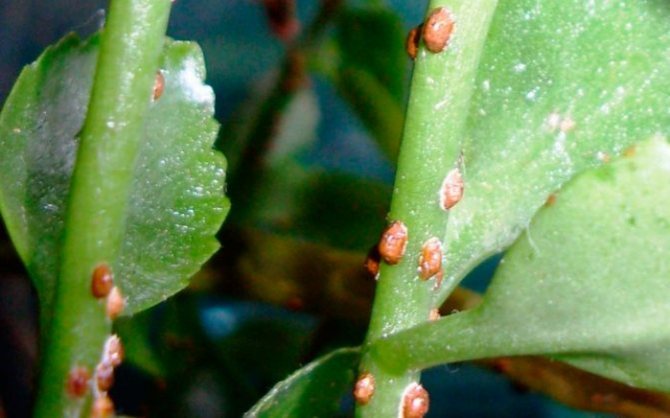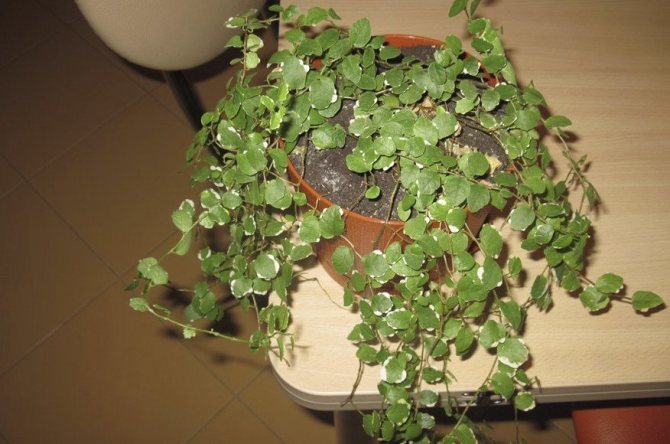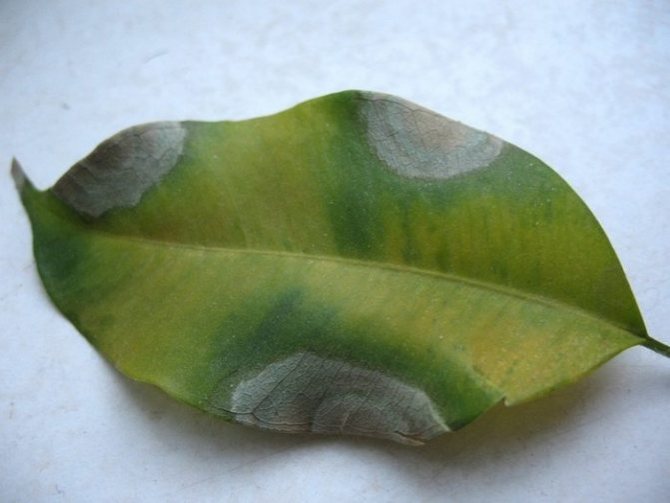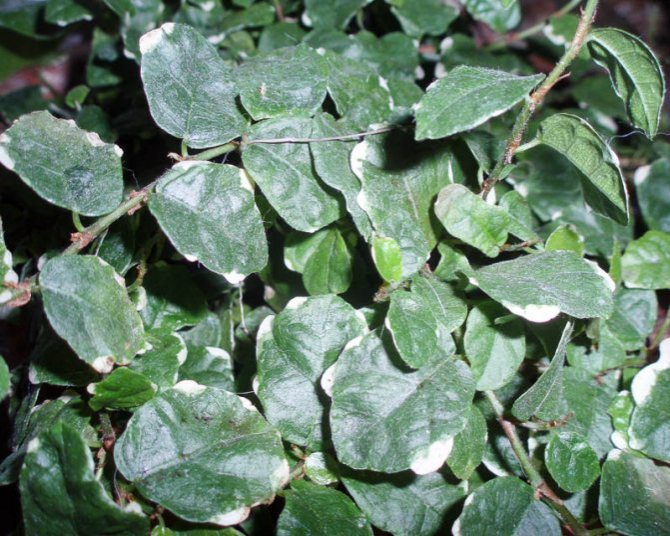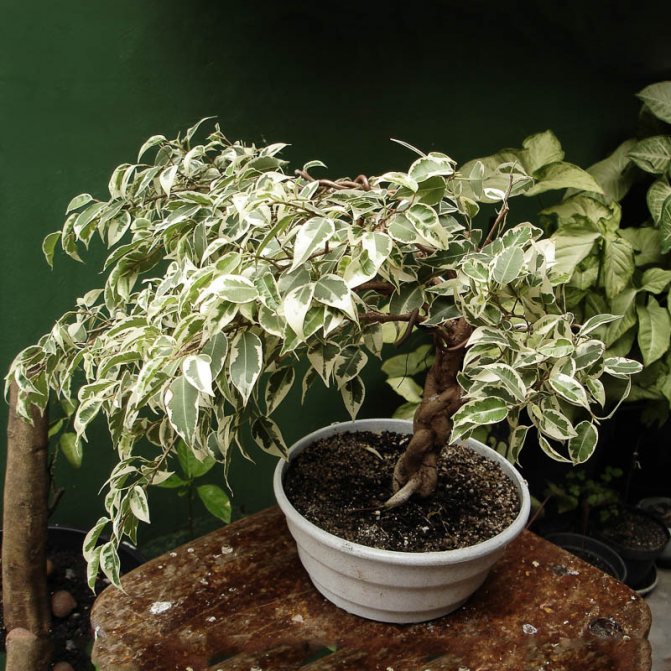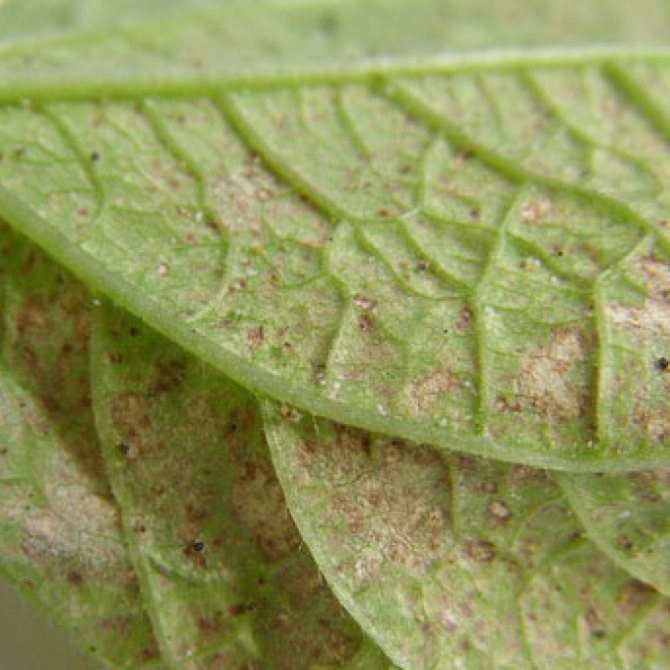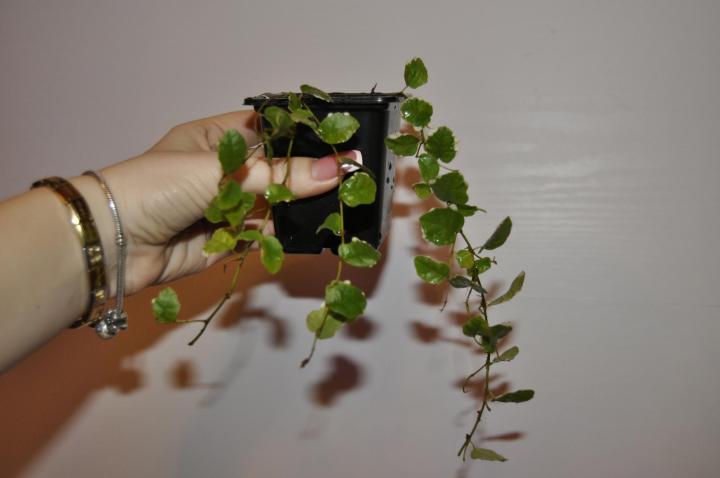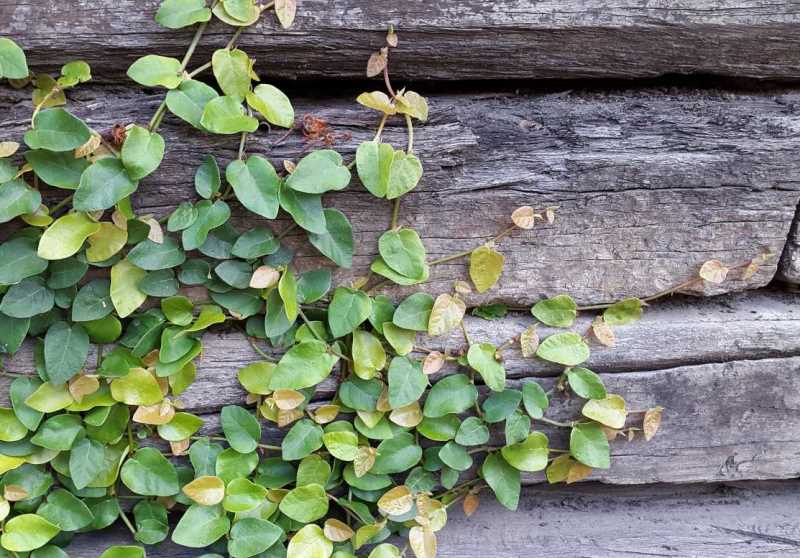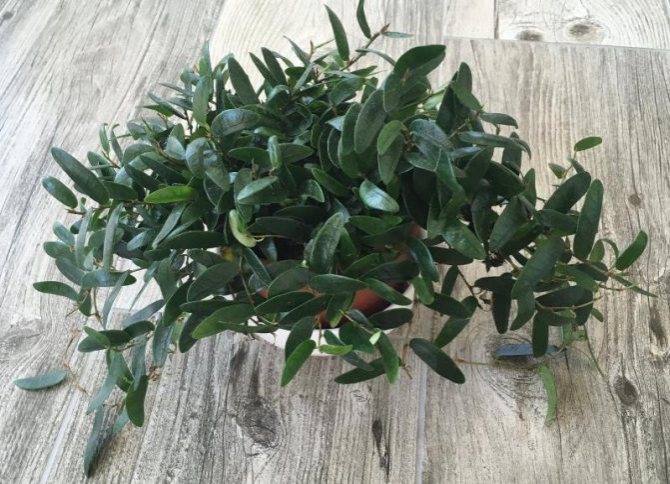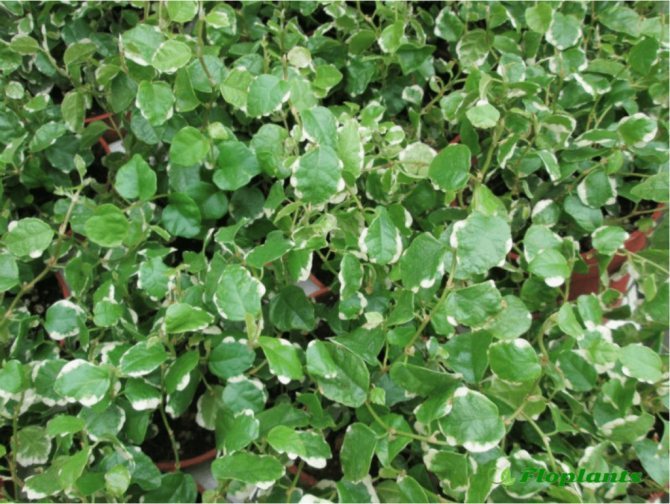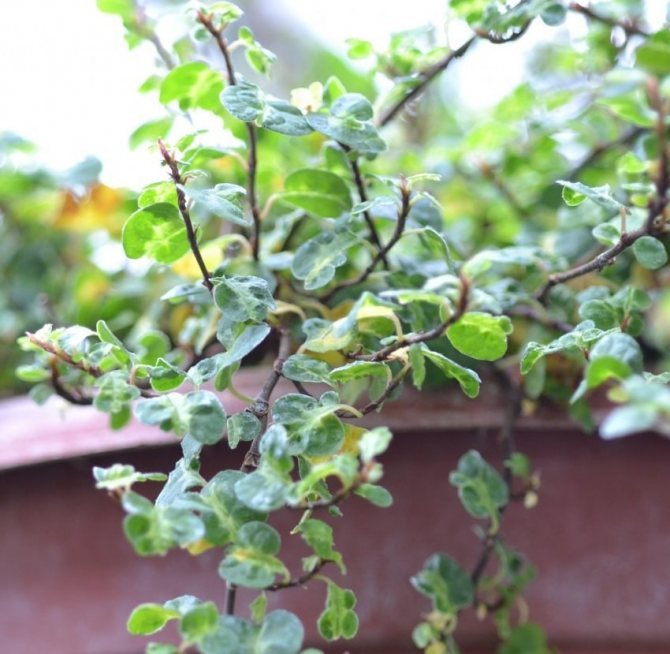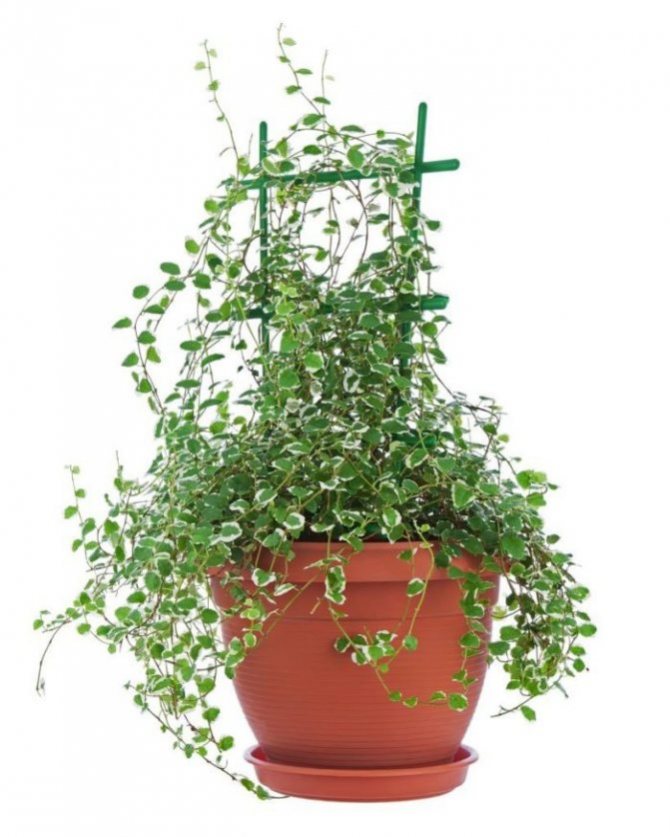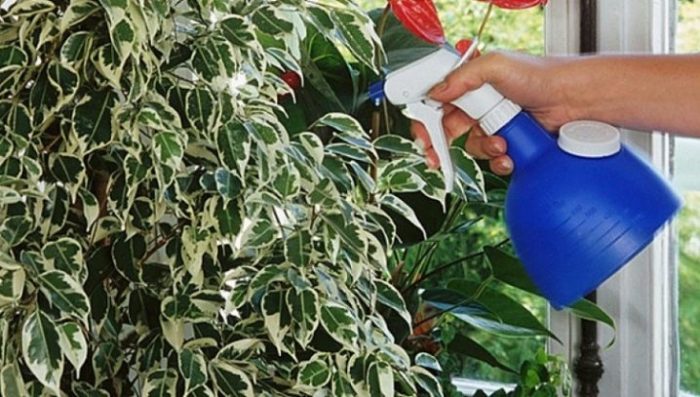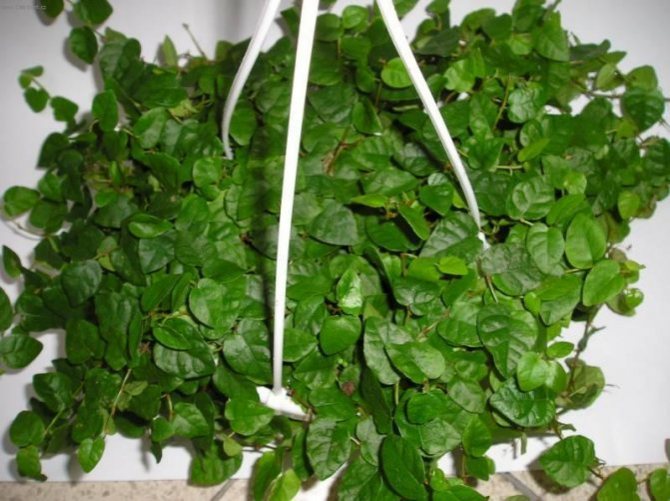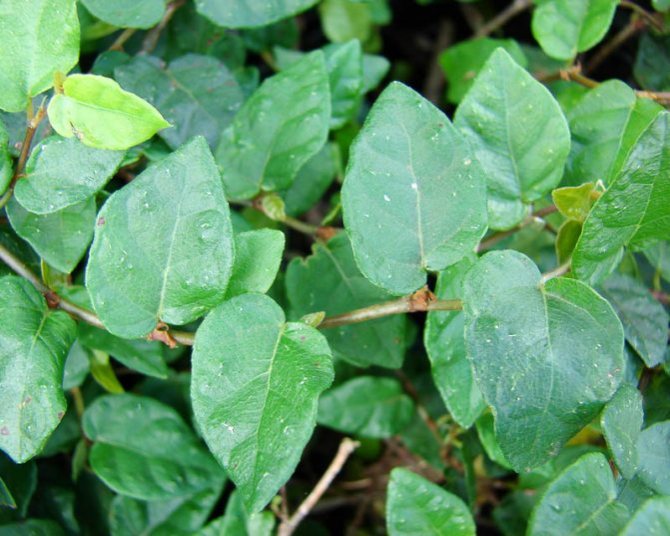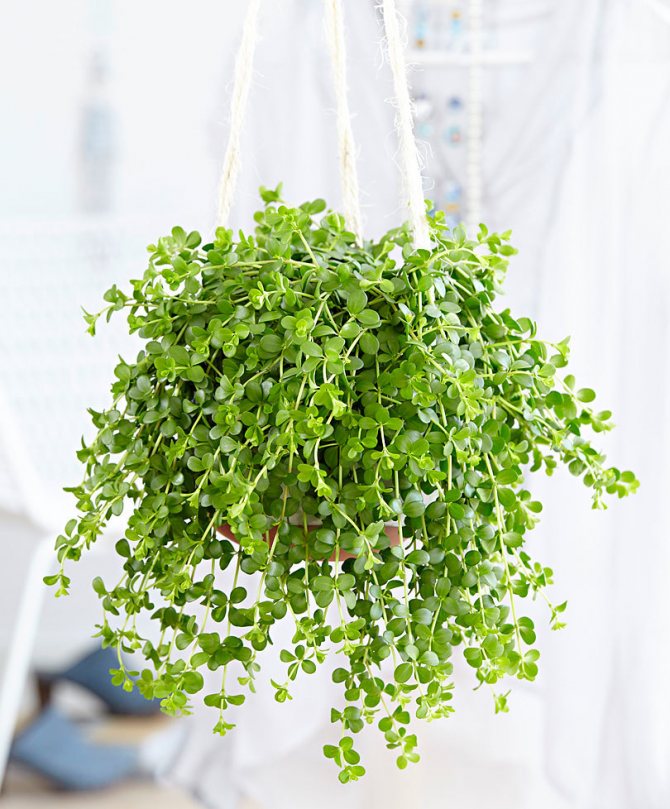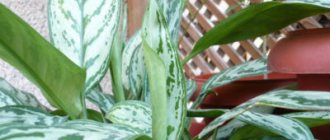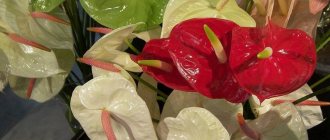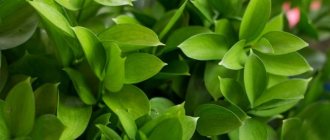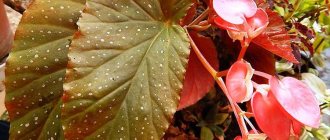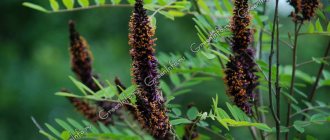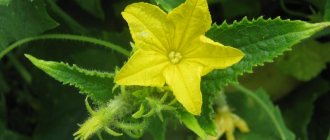Getting to know the plant
Ficus ampelous, whose shoots hang so picturesquely from the pot, by its appearance creates a joyful mood, and its bright leaves perfectly clean the air of toxins, enrich with oxygen. Dwarf ficus Anuk is a rather rare plant with small elongated bright green leaves.
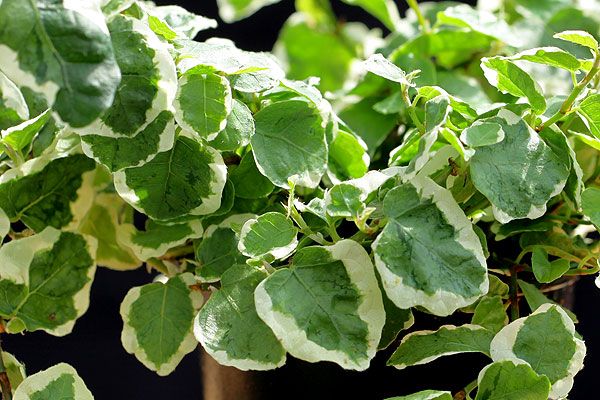
Its close relative, the ficus Pumila White, has elegant heart-shaped leaves, not exceeding 3-4 cm long and 2 cm wide, attached to a branch with short petioles. White Sunny has a light dotted border around the edge of the leaves, and the ficus Sunny has a wider, uneven white or cream border.
When grown indoors, these ficuses have only juvenile leaves and slowly lignified shoots, they do not bloom, do not bear fruit. Under natural conditions, dwarf ficus is a very strong, tenacious, tenacious plant that can quickly grow up to 4 square meters, occupying land or trees, clinging to them with aerial roots.
Only in nature does it grow mature lignified shoots with large leathery leaves, on which inflorescences and fruits are formed - syconia, which change color from green to orange as they ripen. The fruits are not eaten, but used in folk medicine.
Domestic dwarf ficuses are delicate graceful plants with weaker roots, they need careful care, which means that you need to follow some rules.
Reproduction
Propagated by upper cuttings with two or three developed leaves, they take root perfectly in water or directly in the soil.
It is best to plant the cuttings in the ground with soil heating, while covering the ground with a film.
It also reproduces successfully by layering.
REFERENCE: Layering is a method that is used for vegetative propagation of plants, when the shoot is not cut off, but pressed against the soil in another pot or in a neighboring garden.
Temperature
Air temperature is required in summer 15-25 ° C, in winter not lower 7 ° C.
PumilaWhiteSunny is more thermophilic among other species due to the bright color of the leaves.
Lighting and temperature
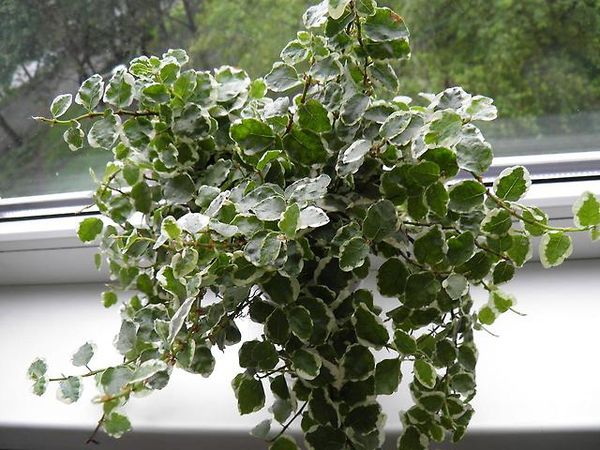

Dwarf ficus loves diffused sunlight, can live in partial shade, but in two-color varieties, with a lack of lighting, the color will firmly establish green. Therefore, it is better to choose eastern or western window sills for them, on the south side you will have to shade or move away from the window by 1 meter. The lack of lighting can be replenished with fluorescent lamps, if this is not done, then you can get not only a loss of decorativeness in variegated ficuses, but ampelous plants can form shoots without leaves at all.
The comfortable air temperature for dwarf pets should be between +18 and +25 degrees, in winter it is lowered to + 12-14 degrees, with a mandatory reduction in watering. I must say that this is important only for indoor conditions, in nature, creeping ficuses easily tolerate even negative temperatures, but there they have completely different roots.
The winter period of dormancy should be arranged with a decrease in temperature, cessation of fertilizing and a reduction in watering, but the illumination in winter should remain at the same level.
Home care
Both the species form and varieties of Ficus dwarf are perfect for growing in hanging pots as an ampelous plant or for forming fluffy sheer columns using specialized supports. At the same time, it is completely easy to care for the plant. It is enough to adhere to a few following requirements.
Lighting
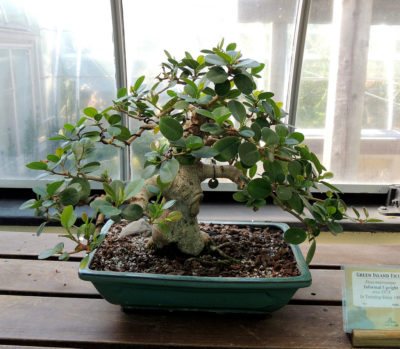

Dwarf ficus takes direct sunlight, slight shading or diffused light.
A flower pot with ficus can be installed on windows facing east, west, north, and even in the middle of the room, away from the window.
If the plant has little illumination, then it will be possible to notice it by the elongated shoots and the reduction in the volume of young leaves.
Green types of ficus need less lighting than variegated ones.
Temperature
In the summer, a dwarf ficus is suitable for a temperature range from 18 to 25 degrees Celsius., but in cool winter time, ficus is able to grow even when the temperature drops to 8 degrees... Of course, in winter, the ficus will endure well the cold temperature only with low humidity and the least watering.
Planting and transplanting
Obligatory annual transplant is needed only for young plants under the age of 4-5 years. Adult ficuses are transplanted every 3 years. A flower pot for a dwarf ficus must be chosen shallow, but of considerable diameter.
Watering
Ficus belongs to moisture-loving plants, for this reason it needs rich and constant watering. It is necessary to find the best balance so that the earth is constantly slightly moist, but without stagnant water. Watering must be done on time, it is impossible to allow the earth lump to dry out. Lack and excess of moisture are equally dangerous to the life of a perennial.
Important! It is recommended to settle water for irrigation within one or two days. Its temperature should be at least 20-22 degrees.
The soil
The soil for a dwarf ficus should be neutral in formula with absolutely all high-calorie components that indoor flowers need. It is possible to personally make a soil mixture at home, combining the same proportions of peat, turf and leafy soil, and in addition coarse river sand.
Fertilizers
It is recommended to apply fertilizers 2 times a month, from early spring to late autumn. A perfect option is a ready-made liquid top dressing for domestic deciduous plants. Top dressing of dwarf ficus is performed from March to September every 2 weeks with liquid fertilizer for domestic plants. Such fertilizers as "Izumrud", "Balm for plants", "Florist Rost", "Florist Micro" and others are suitable for this. In the autumn-winter period, it is possible to feed the ficus, only with a very weak fertilizer substance. and no more than once a month. Dwarf ficus should be treated carefully, since when a very significant dose of fertilizer is applied, it begins to lose leaves.
Reproduction methods
In order for the ficus to grow actively, create new branches and actively weave, it must be periodically pinned. This is done in early spring, cutting off young shoots up to 7 cm long. It is also recommended to propagate ficus in spring, and young cuts are just ideal for this.
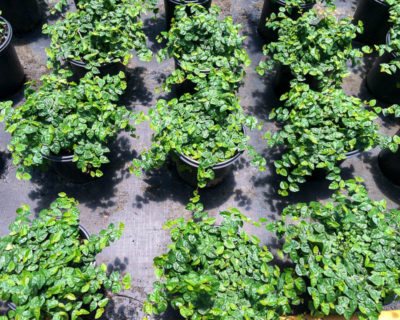

Dwarf ficus propagates most effectively by cuttingsthat take root in water without any problems. It is enough to put the cut in a vase and put it in a warm, not very bright place for 10-15 days. During this time, the stalk will start up roots and it can be rooted in the ground.
Also, cuttings take root well in wet soil and vermiculite. It is very important that the soil is nutritious and not depleted. Therefore, the soil must be fresh.Many believe that it is best to propagate a plant in the soil in which the mother tree grows, but this is a false opinion.
That soil is already depleted and the young plant will not absorb all the necessary minerals for further growth. If you do not want to damage the plant and are afraid to cut off the young sprout, you can propagate the ficus by layering. To do this, a pot of fresh soil must be placed next to the plant.
Find the branch of the ficus in the root zone, which has the least number of leaves. This twig does not need to be cut, it must be taken to a free pot and stuck into the young soil (pinned). The soil in the drainage pot should always be moist, but not wet. After about 3 weeks, the branch will begin to sprout roots and young bores will appear on it, then it should be split off from the mother plant.
Watering and moisture
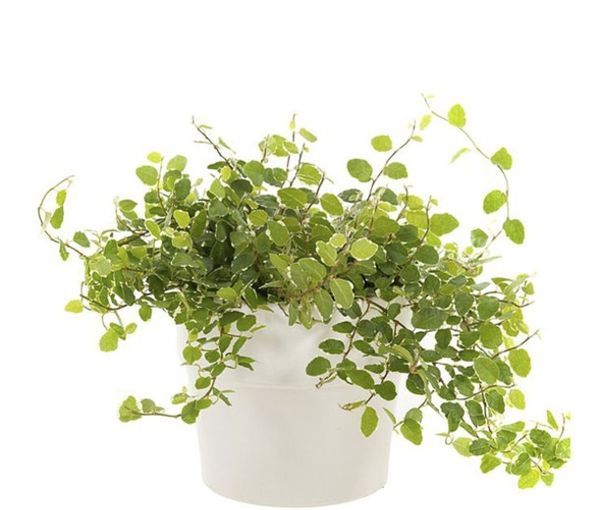

Dwarf ficuses love moisture, but their roots will quickly rot from constant stagnation of water. Therefore, it is necessary to water the plants evenly, preventing the soil from drying out deeper than one centimeter from the very top. The roots are rather weak, they are located close to the surface, so they need to be moistened in a timely manner, since they will not be able to extract the remaining moisture from the bottom of the pot. In winter, watering is reduced, the earthen lump should dry out completely, but it is important to ensure that the soil does not dry out to a state of dust. Water should be used warm, clean and soft, without chlorine, for which it will have to be purified or at least defended. Numerous leaves quickly evaporate moisture, it must be replenished by spraying if the air humidity level is below the required level. When growing on a vertical support, a high level of ambient air humidity is very important - only when there is sufficient humidity, aerial roots grow, which cling to the support. With well-organized care, even ampelous plants receive a weekly warm shower: the water not only nourishes the leaves, but also removes dust from them, which interferes with the process of photosynthesis.
Use of dwarf ficus
In indoor conditions, given its climbing abilities, dwarf ficus can be tied to a support, for example, to a ball frame, and grown as a topiary, or as a low ground cover plant at the foot of tall plants. Dwarf ficus looks beautiful as an ampelous plant, it can be used for wall landscaping of offices.
Dwarf ficus is used in the art of bonsai and wabi-kusa. It is often marketed as a terrarium plant for making wabi-kusa, as it grows quickly in humid conditions because it is considered a quick and cheap terrarium litter.
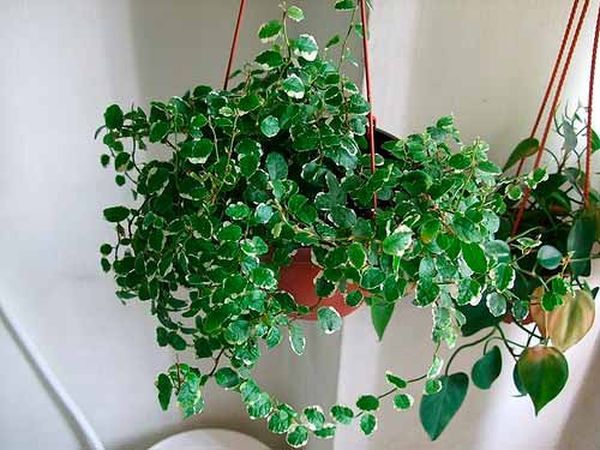

Dwarf ficus soil needs fertile, light, neutral, it can be slightly acidic or slightly alkaline, but not go beyond pH 5.5–7.5. For the first four years, it is advisable to replant young plants annually in the spring before the start of the growing season. For adults, it is enough to change the top layer of the earth, if the roots do not suffer from this.
The pot can be earthen, glass or plastic, as long as there are holes to drain excess water. It should not be too deep - the depth can be equal to the width of the pot. At the bottom, you need to organize a good drainage layer, and then pour soil.
It should consist of well-rotted compost, leaf, turf and peat soil, sand and wood ash must be added to it, then subjected to heat treatment. In order not to bother with compiling the soil, you can buy a universal primer at your nearest specialty store.
From spring to autumn, plants are advised to feed a couple of times a month with complex fertilizers for decorative deciduous (that is, not flowering) plants.Experienced growers recommend planting them slightly more than indicated on the package, since underfeeding the plants is better than overfeeding.
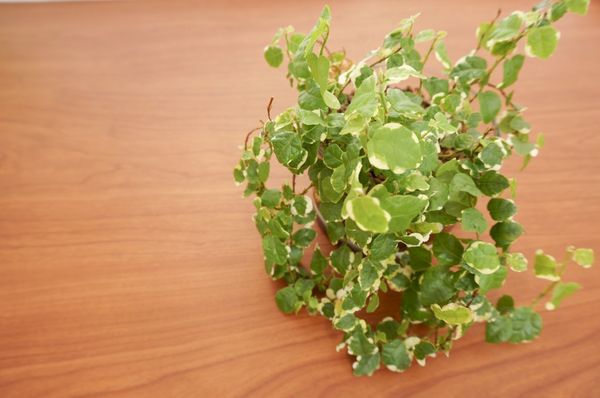

How to choose a flower pot
When choosing a pot, you need to pay attention to the presence of special holes for dumping excess liquid. The material from which the container is made can be anything: glass, plastic, clay. The main thing is not to purchase a deep and large pot for decorative ficuses, in which the stems will grow slowly. For dwarf ficuses, you can use pots. Before transplanting the plant, a well-ventilated drainage layer is placed on the bottom of the container, and then a special soil is poured.
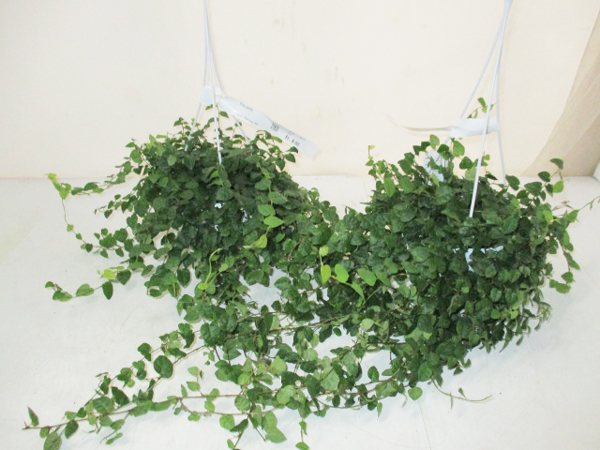

To gently and accurately remove the ficus from the container, it must be watered in advance. A healthy flower can be transplanted into a new pot without freeing the roots from the soil if the soil has not been contaminated. If this happens, then, of course, it is worth removing all the lumps. An overgrown plant can be divided into several bushes, damaging the roots as little as possible. Then fertilizer is added to the ground and the flower pot is placed in the light. If the ground is wet, then additional watering after transplanting is not required.
What to watch out for
Proper home care will help avoid trouble, but sometimes ficuses are threatened by scale insects, thrips or spider mites. A warm shower, a soap-ash solution or special preparations will help to remove pests. Then you need to restore comfortable conditions for the plant and properly care for it. Too dry air, insufficient watering can lead to curling, drying of the leaves. Sour or too compacted soil leads to yellowing and leaf fall. When they grow smaller and paler, they need to be transplanted into more fertile soil. The plant can quickly lose leaves due to a draft, a sharp drop in temperature or a lack of light, waterlogging of the soil will also lead to this.
If variegated varieties, after stress, form pure green leaves on new shoots, it is better to remove them immediately, otherwise the whole plant will simply turn green.
Transfer
It is recommended to transplant dwarf ficuses in the spring. Experts advise doing this every year, since the root system of this plant quickly absorbs nutrients from the soil.
Adult ficuses (from 5 years old and older) should not be disturbed by frequent transplants, it will be enough to carry out the manipulation 1 time for 2-3 years.
Drainage is necessarily laid out on the bottom of the pot, then specially prepared soil. The roots of the plant are gently sunk into the soil. At the end of the transplant, it is recommended to water the plant with warm water.

